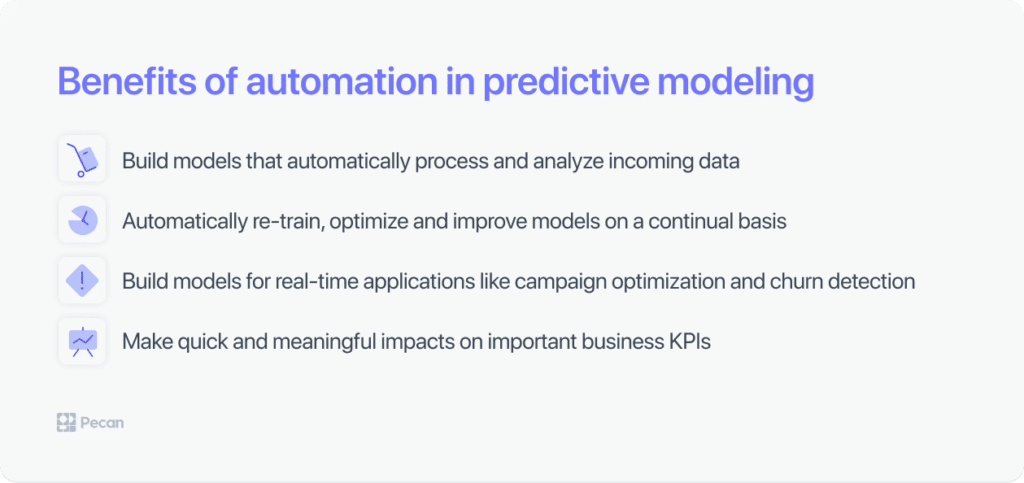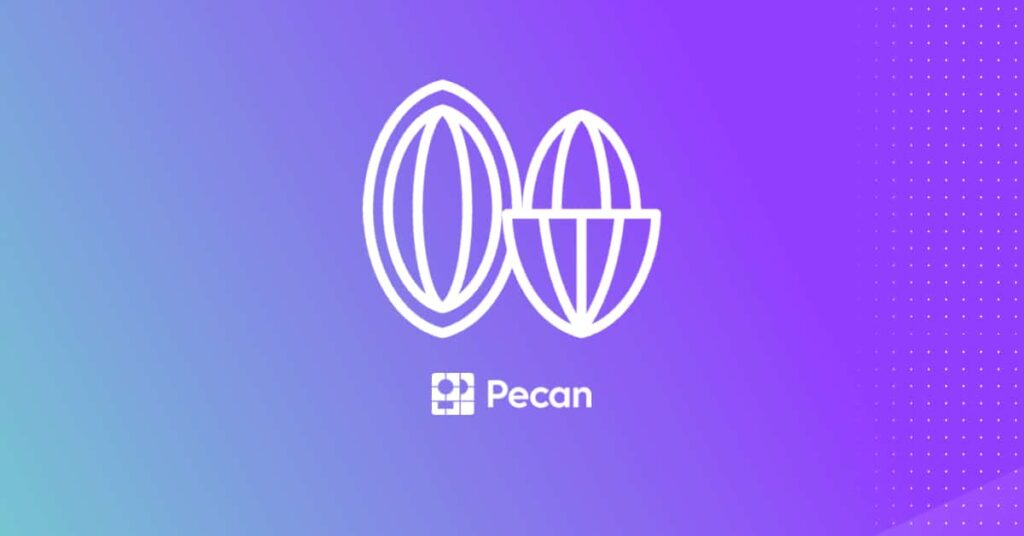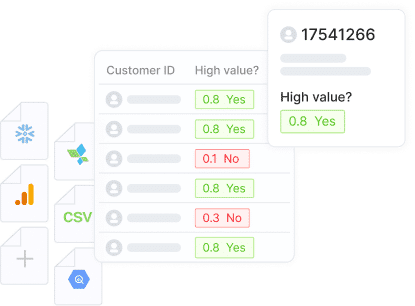Life has a way of throwing curveballs to us humans. One way we have evolved to navigate the complexities and uncertainties of life is through a variety of mental heuristics that equip us to make fast, effective and generally accurate decisions. We’ve also been blessed with biological systems that keep us healthy and alert without even being aware of it.
On the technological side, we’ve designed all sorts of solutions that boost our mental capacity, save time and improve productivity. They streamline and automate many of our everyday activities, from making coffee to organizing photos to investing money to managing work schedules.
Automation helps us accomplish a similar feat in the domain of predictive analytics, where there are all sorts of challenges related to processing data and analyzing information so we can make predictions about the future. Traditionally, these barriers could only be overcome through the hard, and often tedious, manual work of experienced data scientists and engineers.
But automation changes everything – making it possible for any company to build predictive models when the amount of data is vast, the process is difficult to manage, and they don’t have the highly specialized personnel to deal with it.
Why automation is important for predictive modeling
Predictive modeling involves the use of machine learning algorithms to analyze data and make predictions about future outcomes. It calls for a significant amount of data pre-processing (such as data cleaning, feature selection, and normalization), as well as a number of other operations – all of which can be time-consuming and error-prone if done manually.
Automating predictive analytics enables you to streamline many of those processes, reduce the risk of errors, and easily integrate predictions into your existing data and business systems. That way, all you need is a data analyst who can perform essential data functions so the model knows how to ingest and interpret your data – automation will take care of the rest.
These automated capabilities mean you’ll be able to rapidly build, deploy and scale predictive models for your organization.
Some of the key benefits are highlighted below:
There’s another important benefit here, and it has to do with human resources. As we explained in a recent article, there are several reasons why data scientists should not be your go-to people for creating predictive models.
Rather, you should look to data analysts who, ideally, will be embedded within existing business teams. These people are typically equipped to handle certain tasks like ETL processing and data cleaning.
The problem? They’re generally unfamiliar with other key tasks related to predictive analytics, such as preparing data specifically for machine learning, engineering model features, and selecting algorithms.
This is where automation comes into play. Predictive analytics platforms that provide automation can handle the complex parts of predictive modeling, so specialized data-science skills are no longer needed. But more on that in a bit.
Now that we’ve covered some of the benefits, let’s take a moment to acknowledge the costs of not leveraging automation in predictive modeling.
What happens when there’s no automation?
When automation capabilities (which are detailed in the next section) are non-existent, you can expect several things to occur:
- Predictive models are no longer accessible to data analysts and business owners. Only data scientists who are experienced in predictive analytics are able to build, deploy, interpret and monitor models.
- The creation of models requires months of heavy lifting, with manually performed tasks like feature engineering, results visualization, and of course, the model-training process itself.
- If a model is successfully created, it will have taken months to reach a point where you can turn results into action and begin to realize business impacts.
- There’s no easy way to integrate model outputs (a.k.a. predictions) alongside other company data so they can be easily acted upon.
- If the model fails to deliver meaningful impact or exhibits performance issues, which is quite common, the data scientist must re-start the modeling process – often from scratch.
Furthermore, a model’s predictions must be current and based on the most recent data in order to be accurate and continue to serve its purpose. If a data professional must constantly manage incoming data, monitor and optimize model performance, and manually interpret and communicate the results, these extra tasks increase their workload and keep them firmly behind the curve.
Automation spares them the tedious and most intensive parts of the modeling process. Without it, data professionals are set up for mediocre performance at best – and more often than not, they fail to deliver timely and meaningful impact.
What parts of predictive modeling can be automated?
The short answer? A lot more than you think.
The long answer? You can automate most of the essential tasks, and especially the most complex ones. The result is that virtually any data analyst or data-oriented professional will be able to build and deploy predictive models that address real business needs.
Let’s get specific. Here are some parts of the modeling process that can be automated by a best-in-class predictive analytics platform:
Connecting data sources (via native integrations)
With native integrations between your company’s data sources (e.g., data server or warehouse) and a predictive analytics platform, data analysts can save many hours that would otherwise be spent exporting, importing, and uploading data.
Cleansing and structuring data
For machine-learning algorithms to be able to learn from your data and make predictions, your data must be structured in a specific way. A predictive analytics platform will help you create a reusable blueprint that automatically queries data in that set way, so your data can be fed into the model both now and in the future. You can set it and forget it.
The AutoML process
Ultimately, AutoML (automated machine learning) is what turns predictive modeling – a domain traditionally restricted to data scientists and engineers – into something that can be performed by any data analyst or business professional.
AutoML is the heart of automated predictive analytics, including tasks like feature engineering, algorithm selection, model evaluation, model selection and hyperparameter tuning.
Let’s look at feature engineering as one key part of AutoML. Whereas data scientists typically only have the ability to produce predictive models that include a handful of features (a.k.a. variables), a machine-learning model can contain hundreds of them.
An AutoML-based platform can not only automatically generate many more features, but it will also select the most useful among those it creates and enrich your model with them. These features, which are based on your data, are often not detectable by the human eye.
We won’t go into further detail in this article, but you can learn more about AutoML here.
Scheduling and exporting predictions
As mentioned earlier, a model’s predictions must be current and based on the most recent data in order to be accurate and useful. Automation makes this possible without increasing a data analyst’s workload.
An end-to-end predictive analytics platform will do the following:
- Automatically import new data and feed it into machine-learning algorithms. This may be for the purpose of generating new predictions or re-training an existing model.
- Allow you to schedule recurring predictions – so your predictive model can run like clockwork and generate predictions based on the most recent data.
- Automatically export predictions to your business system of choice, such as a CRM, ERP, BI tool, or database. With model outputs appearing alongside your company’s existing data, business teams can easily use them to start driving business value.
Model visualization
It would all be for nothing if you weren’t able to monitor and gauge the success of your model. This calls for reports and visualizations of its results, and putting those together is a complex and time-consuming effort – especially when real-world outcomes must constantly be compared against a model’s past predictions.
A predictive analytics platform will automatically provide you with visualizations and reports so you can understand a model’s predictions, assess feature importance, tinker with precision thresholds, and view performance metrics. This enables any data analyst, and even the average business professional, to interpret a model’s results and understand how to act on them.
Let’s look at it another way…
There are many data-science tasks involved in predictive analytics. In the below chart, on the left side, you’ll see a breakdown of those tasks and how much time and effort they consume (based on Anaconda Research’s 2020 State of Data Science report).
Meanwhile, on the right, you’ll see how much of that work can be automated by Pecan’s predictive analytics platform.
Conclusion
Automation is important, dare we say essential, for predictive modeling. It enables efficient processing and analysis of large amounts of data, makes machine learning accessible to any data-driven business, and makes it easier to act on predictive outcomes.
By automating tasks such as data pre-processing, feature generation, and model selection, you can manage the complexities of predictive analytics, streamline work processes, and make accurate predictions in days, not months.
Indeed, most data analysts already possess the skills needed to perform predictive analytics. They just might not know it yet.
Now, the only question is, how do you choose the right predictive analytics strategy for your team? Download our free worksheet so you can evaluate your data and determine if it’s ready for predictive analytics, and to find out what questions to ask your internal stakeholders in order to ensure alignment.
Get started now with a free trial of Pecan’s low-code predictive analytics platform today, or contact us to set up a time to chat about Pecan and your team’s needs.








